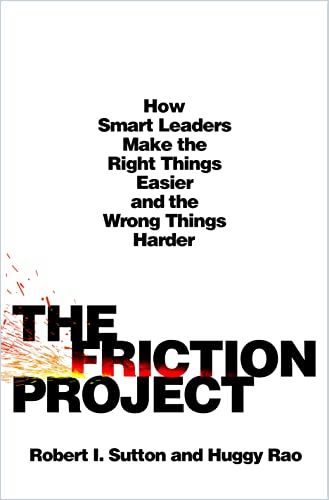Robert I. Sutton and Huggy Rao explain how organizational friction works, for good or ill, and how to use it productively.

Friction or Not
Stanford University organizational researcher and management professor Robert I. Sutton and Stanford Graduate School of Business organizational behavior professor Huggy Rao argue that positive friction spurs thoughtful decision-making while negative friction may hobble productivity, collaboration, and communication.
Sutton also wrote Good Boss, Bad Boss, The No Asshole Rule, and other business books including the upcoming A**hole Survival Guide: How to Deal With People Who Treat You Like Dirt.
Friction
Organizations should strive to eliminate destructive friction, but they shouldn’t aim for a “frictionless” workplace. For example, companies should restrain a leader’s ability to pursue potentially risky strategies – such as when Google rushed the introduction of Google Glass and met with disdain in the marketplace.
Friction problems squander the zeal, damage the health, and throttle the creativity and productivity of good people – and burn through company cash and other precious resources.Robert I. Sutton and Huggy Rao
Friction snafus persist because they are often “orphan problems” – no one in the organization is officially responsible for addressing them. Instead of letting problems fester, Sutton and Rao advise that people at all levels should assume the role of “friction fixer.”
Due to their privileged positions, top leaders may remain ignorant of the friction their policies are imposing on their employees and customers. For example, General Motors provides its executives with new cars, gas, and maintenance services for $250 per month. This freedom from the usual responsibilities of car ownership means that these auto industry executives have insulated themselves from their customers’ issues.
The similarly friction-producing “executive magnification” effect occurs when bosses don’t understand that employees analyze everything their leaders say. A careless remark can add unnecessary costly friction. For example, Sutton and Rao cite the case of a CEO of the 7-Eleven convenience store chain who complained about an ill-mannered clerk he encountered at one location. In response, his managers launched a multimillion-dollar program aimed at improving clerks’ courtesy. When the boss learned about the program, he judged it a waste of money and put a stop to it.
The cognitive phenomenon of addition bias is another major source of friction. When people confront a problem, they usually try to solve it by adding something. In business, this means hiring more staff, introducing new training programs, adopting the latest management fads, or instituting new procedures. Businesses reinforce addition bias by rewarding team members who add new steps rather than those who remove obstructions.
Sutton and Rao offer a way to counter addition bias by adopting a “subtraction mind-set.” For example, Dr. Melinda Ashton of Hawaii Pacific Health found that excessive recordkeeping responsibilities were eating up doctors’ and nurses’ patient-care time. The problem lingered because no one had responsibility for reining in red tape. Ashton’s team launched the “Getting Rid of Stupid Stuff” program, asking medical staffers to identify specific requirements that they considered needless or too complicated.
Organizations often provide potent incentives…including prestige, money, and interesting work – for adding burdens that inflict collective harm.Robert I. Sutton and Huggy Rao
Snafus in coordination breed friction. A company’s different sectors must mesh. People in each sector should be aware of the activities of those in other units. Sector leaders should draw on each other’s knowledge and experience. Without such coordination, a company’s product designers, for example, might submit a design that the manufacturing team cannot produce. However, cooperation complications are often orphan problems.
Jargon also generates friction. Many leaders indulge in trendy business expressions, which undermine efficiency and collaboration by thwarting communication and fostering confusion.
The authors advise you to remain aware of insider language that most employees can’t decode because it doesn’t mean anything outside of a narrow sphere. Jargon may be productive in some settings, for example, among surgeons and their teams in an operating room. Their words may be incomprehensible to outsiders, but their specialized lingo coordinates quick action.
However, a specialized vocabulary can lead to harm if newcomers or outsiders can’t understand what the members of a specialized group are saying. For example, such argot helped fuel a financial disaster in 2007 when bank managers didn’t adequately oversee the trading of mortgage-backed securities. The managers found the related slang incomprehensible.
Slowing Down
Pushing for speed leads to poor decision making and employee burnout, discourages team members from assisting or supporting others, encourages abusive leadership practices, impairs judgment, and undermines creativity.
As Google discovered with Google Glass, first movers don’t always win. Sutton and Rao suggest slowing down, analyzing a potential strategy dispassionately, and learning from the mistakes of competitors who preceded you in a market.
Before you heap some burden on people and eventually figure out that it wastes their time (or worse), slow down and ask, ‘Suppose we did nothing’?Robert I. Sutton and Huggy Rao
When participants need sufficient time to do an activity correctly, increase the friction to slow things down. Team members need time to invent and most likely reject a string of ideas. When a creative team finds a viable idea, the members must patiently refine it through a series of iterations and modifications.
Although organizations should strive to eliminate destructive friction, they shouldn’t aim for a “frictionless” workplace. Some activities should remain difficult to execute. Customers may also appreciate guardrails. In one case, Amazon had made online purchasing so friction-free that a six-year-old accidentally ordered a $162 dollhouse while conversing with Amazon’s voice-activated Alexa device.
Friction Fixers
Leaders can bring about change throughout their companies, but Sutton and Rao say managers and their team members should pause before launching a new project to contemplate which people, skills, and resources increase the likelihood of success.
Top executives can gain insight into friction problems by listening to their subordinates. For instance, when Dan Cockerell ran Disney’s All-Star Resort, he improved the housekeeping crew’s efficiency by spending two weeks shadowing the most capable housekeepers and studying how they organized their work.
Friction troubles wane and do less harm when…everybody in a team or organization does what they can, from where they are, with what they have, to make things better.Robert I. Sutton and Huggy Rao
During the COVID-19 pandemic, Microsoft’s learning and development team noticed that employees struggled with fatigue due to back-to-back virtual meetings. Managers responded by reducing meeting times by five to 10 minutes to create a buffer between sessions. Senior executives at Dropbox dealt with time-eating meetings by introducing “Armeetingeddon.” They removed almost all standing meetings from the calendar and forbade employees to call new meetings for two weeks.
To reduce resistance to your friction-fixing initiatives, introduce them as prototypes subject to modification. Make it clear that if these ideas don’t work, the organization can scrap them and replace them with new ones.
A New Prism
Robert I. Sutton and Huggy Rao bring a unique perspective to pervasive and intractable issues within organizations. Most of their proposed solutions to organizational logjams may seem familiar, but the prism through which they examine those logjams – the amount of friction they generate or resolve – is revelatory and will offer you new methodologies for coping with entrenched bottlenecks or miscommunications. The authors help you identify sources of positive and negative friction and show you how to turn them to your benefit. That act of identification may be their book’s most valuable aspect. And Sutton and Rao capitalize on that value by demonstrating how friction can be productive.








